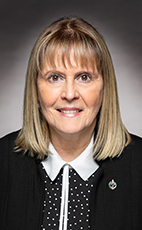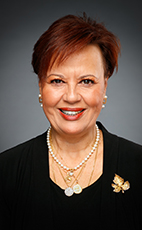44th Parl. 1st Sess.
December 9, 2022 10:00AM
Madam Speaker, I remember an elder talking to me very clearly when I asked a question about colonization and the impacts of all the factors of colonization and what it stole from communities and indigenous people in terms of their traditions and knowledge. I remember the elder told me two things. One is that they worked really hard to maintain and hide what they needed to pass on to their children. On the other side, they believed fundamentally that children born into the earth brought back from the spirit world the traditions that were lost. I am wondering if the member could speak to that.
105 words
All Topics
- Hear!
- Rabble!
- add
- star_border
- share
Madam Speaker, the member for North Island—Powell River is a mother to indigenous children, and I know she is very passionate about sharing those teachings and raising her children to be proud.
Her question reminds me of another story I heard from an elder recently who was speaking about indigenous languages and teachings. One of their children mentioned to them that languages and cultures were in danger of dying out and that they had been hidden. The elder was quick to correct them and said that no, they had always been there, and they are there for the people of today to reclaim and to be proud of. If we listen and seek out these teachings, they are ready for the taking.
Back home in Wolastoqey territory, some proposed the Wolastoqey language would be extinct by now, and it is not. It is revitalized and is thriving, and there are immersion schools. These are all pieces of the puzzle, and it really feels like we are entering this period of healing. That is what reconciliation is all about.
180 words
All Topics
- Hear!
- Rabble!
- add
- star_border
- share
Madam Speaker, Bill S-219, an act respecting a national ribbon skirt day, was introduced in the Senate by the Hon. Mary Jane McCallum on November 24, 2021. I was blessed to have the opportunity to attend and participate in the study of the bill at the Standing Committee on Indigenous and Northern Affairs this past Monday, where it passed, and now here we are in third and final reading. I want to thank Senator McCallum for being at the heart of creating a national ribbon skirt day throughout Canada, which, upon the passing of this bill, will be celebrated every January 4.
The Cote First Nation and the community of Kamsack are neighbours in my riding of Yorkton—Melville. On December 18, 2020, 10-year-old Isabella from the Cote First Nation wore a ribbon skirt to her school in Kamsack. She knew the special meaning behind her ribbon skirt. She knew it was a centuries-old spiritual symbol of womanhood, identity, adaptation and survival, and is a way for women to honour themselves and their culture. That day, Isabella was told that her outfit was inappropriate for formal day, that it did not match and that next year she should wear something different.
I want to say directly to Isabella that I am so sorry she was exposed to such a hurtful and devastating experience and that it was embarrassing and humiliating. I note how she, her sisters, her mom and dad, Chief George and their Cote First Nation family chose to respond to such a grievous experience, how she responded to international attention and how she chose to respond to the Good Spirit School Division, her school and the wrong that she experienced. She did it with fortitude wrapped in a giving heart and with a mind that saw the good that can come out of a place of sorrow.
As I listened to Chief George and Isabella's dad speak at committee, their words brought to light the source of her strength, and I think it best for me to share some of those words with Isabella today and the people who are listening so we understand where her strength comes from.
Chief George said, “In the spirit of truth and reconciliation, talking with Chris and Lana, we decided to make this have a positive impact on our nation.” They decided that they would have a ribbon skirt day and Isabella would wear a ribbon skirt, along with all of the women and her peers, on a special day to specifically acknowledge what she went through.
Chief George described the ribbon skirt as:
...something that our community and our ladies have been wearing in ceremonies. It represents a lot of issues with regard to what our people have been going through, with murdered and missing women, suicide and a lot of the addictions that are in our community. It's a way of us coming together and healing.
He spoke of the participation of the Good Spirit School Division, the Cote First Nation and the Kamsack Comprehensive Institute in deciding to come together and come up with a day when this young girl, Isabella, could tell the world her story in a manner that was supported by her dad Chris and her mother Lana. He also spoke of the opportunity with the Good Spirit School Division that opened a door regarding the curriculum to put Cote's language, history and all the things that first nations have gone through into the non-first nations schools; to introduce land-based training, which is about bringing schools out to Cote First Nation to give them an opportunity to participate in cultural activities; and to introduce a cultural room in the school, which some of the elders can visit to share their stories with those who are interested. He shared the desire to ensure that all cultures represented in the school are proud of who they are and can wear their attire at any time, not just on January 4.
Isabella's dad also shared heartfelt comments, saying that the director of education at Good Spirit School Division was very gracious and gave the impression that she believed what he shared about what Isabella experienced. He said:
We were immediately working on solutions.... I remember how we were speaking about faith and belief. I remember speaking about the coat of many colours, and how the Creator made such a wondrous variety of people that we might have fellowship and be close together, learn each other's ways, learn to be tolerant of each other and love each other. These are all values that my family stands very firmly on. We have to be the change that we want to see in the world.
Clearly, those values are represented in who Isabella is and how she behaves.
He continued to say, “I'm raising seven girls”, which is amazing all on its own, “with this in their hearts. I get the strength to do this as a father through my wife and my family's culture. We are just so humbled to be honoured in such a way and to stand for all the first nations and indigenous peoples”.
I do not have a lot more to say, but I want to make sure that I end with at least a final comment by Isabella's father. It truly speaks to why she has been able to turn ashes into beauty and why ribbon skirt day will be remembered as a significant turning point in reconciliation in so many ways. He said:
I think the advocacy that my daughter displayed was definitely through the hand of the Creator. Nothing is by mistake, and the divine nature of what's going on here shows that the Lord is in all things and guiding us all here today to do the right thing and show some unity and some respect and to realize that our mistakes of the past can be righted and that we need to do the best thing for the youth of Canada now. I believe that's what we're doing today.
I want to say to Isabella that I am looking forward to being home on January 4 no matter what. I do not know what else is going on. I will have to talk to the whip possibly because I do not know, but I will be there. I am so grateful for the invitation. Again, this is an amazing achievement of reconciliation, and I am very pleased to represent the Cote First Nation and the communities of Yorkton—Melville.
1112 words
All Topics
- Hear!
- Rabble!
- add
- star_border
- share
Madam Speaker, I would first like to take this precious opportunity to wish happy holidays to all the staff of the House, my fellow members, the interpreters and my constituency office team, Lynda, Mélanie, Jenny, Nancy and Éric.
It is an honour to rise in the House this afternoon to speak to Bill S-219, which creates a national ribbon skirt day to be held every year on January 4. The Bloc Québécois is obviously in favour of the bill, given that it aligns with our party's general position and our commitment to being an ally of first nations. It also aligns with the process of reconciliation with indigenous peoples.
Much like the orange shirt and the red dress, the ribbon skirt has become a very powerful symbol for indigenous peoples and for indigenous women. A symbol of femininity and, quite frankly, resilience, this simple and humble garment is in itself a political manifesto. Although they should not have to do so, these women are putting themselves out there and loudly expressing their right to exist by wearing the ribbon skirt.
The ribbon skirt is a centuries-old symbol of womanhood, identity, adaptation and survival. It is a way for women to honour themselves and their culture. It represents a direct connection to Mother Earth and her sacred medicines. What is extraordinary is that with this symbol that is now recognized by this bill, these women are telling the whole world that despite all the tragedies and attempts at cultural genocide, they are still there, standing strong. They are alive and proud to be who they are.
Designating this day would pay special tribute to these indigenous women as life-givers entrusted with traditional knowledge to care for their families, communities and the environment. Celebrating this symbol would be a way to recognize the fact that indigenous culture, tradition and ceremony, including ties to language and the land, are critical to the vitality and well-being of Canada's first peoples.
Throughout the debate on this bill in the Senate, the sponsor of Bill S‑219 generously shared statements received at her office. One of them, from Isabelle Susanne Kulak, a young 10-year old indigenous girl, represents the essence of this bill. She explains that for her, a ribbon skirt symbolizes strength, resilience, cultural identity and femininity. She says that when she wears a ribbon skirt, she feels sure of herself and proud to be an indigenous girl.
In fact, it is a matter of pride, including among young people, to be able to wear the skirt to honour their kokum, or their grandmothers, and their mothers. Ms. Wapistan, who came to testify at committee, explained that when a person wears a ribbon skirt, “it is about honouring ourselves as indigenous women and honouring our grandmothers and our mothers who wear the skirt every day.”
We are living in an era of reconciliation. It is important to include the indigenous cultures and traditions in public spaces in order to facilitate this reconciliation and allow the expression of their pride. We also recognize that not all indigenous peoples wear the ribbon skirt. Nevertheless, the spirit of this national ribbon skirt day is to celebrate indigenous women, pillars of indigenous communities across Canada.
The Bloc Québécois has repeatedly reiterated its commitment to being an ally to the first nations. The principle of this bill makes it possible to take one more small step forward toward reconciliation by responding to article 15.1 of the United Nations Declaration on the Rights of Indigenous Peoples. It also refers to calls for justice 2.1 and 15.2 of the final report of the National Inquiry into Missing and Murdered Indigenous Women and Girls.
The Viens commission was given a mandate in my riding of Abitibi—Baie-James—Nunavik—Eeyou and, still today, very little has been done to help missing and murdered indigenous women and girls. This is still a problem. I still see posters in my riding when I travel from Val‑d'Or to Chibougamau and around northern Quebec, so a lot of work still needs to be done.
These two calls for justice line up with what the Bloc stands for, which is reconciliation. That is defined as the establishment of a renewed relationship with indigenous peoples based on the recognition of rights, respect, co-operation and partnership.
Specifically, call for justice 2.1 in the final report of the National Inquiry into Missing and Murdered Indigenous Women and Girls calls “upon all governments to acknowledge, recognize, and protect the rights of Indigenous Peoples to their cultures and languages as inherent rights, and constitutionally protected as such under section 35 of the Constitution”.
I am almost done, but before I wrap up, I just want to pay my respects to the friends, families and communities of the four indigenous women who were the victims of a despicable person. Let us hope that reconciliation will be stronger than hate and that people will come to realize that, while we have our differences, we are all human beings.
In closing, the bill refers to “traditional knowledge”. We must never forget that women have managed to preserve that knowledge. That is a fine example of resilience. I hope we all approach this initiative with sincerity as a way of showing these women and their communities that they are no longer alone.
922 words
All Topics
- Hear!
- Rabble!
- add
- star_border
- share
Madam Speaker, first I want to acknowledge the people of this territory, the Anishinabe, for letting us continue to work here. We know that the history is not a good one, but here we are on their territory making the laws of this country.
I also want to take this opportunity to honour all the missing and murdered indigenous women across this country. We know, as we see what has happened in Winnipeg, this raw wound has been ripped open yet again. We know so many people around this country are suffering. I want to recognize and honour the hard work they are doing every moment in surviving this history, surviving this reality now and what that means. Everywhere we go in this country is indigenous land. It is a very special relationship between the first people of that land and the land itself.
I remember years ago speaking with late elder Ellen White from Snuneymuxw. I am so honoured she took the time that she did with me. I expressed my concern about the fact that colonization was continuing to happen, that so much culture was lost due to smallpox, the outlawing of traditional practices, residential schools, day schools and the continued apprehension of indigenous children today. She told me that much of the knowledge was saved, protected and hidden to keep it safe and that everything that was lost came back in the children who were born. They were the carriers of knowledge from the spirit world, so that nothing was ever really lost. That had a really significant impact on me.
When I look at Bill S-219, a bill to make January 4 national ribbon skirt day, it makes me think of how, in spite of everything, in spite of such a targeted effort to destroy the first peoples of this land, they are still here. It makes me think of how the children keep bringing things back to our communities in so many ways. Indigenous children carry inside them this beautiful spirit that will not bend in the face of discrimination, hate or shaming. Therefore, when we think specifically about this day, we have to think about Isabella Kulak who, at 10 years old, inspired a movement based on the pride she had in herself, in her family and in her culture by wearing a ribbon skirt to school.
From the Cote First Nation in Saskatchewan, she wore her ribbon skirt to a formal event at her school. Sadly, an educational assistant made fun of her. Why any adult would feel the need to make a child feel small I can just never understand. The pain perpetrated on children's bodies and spirits over history has never made any sense to me. Indigenous children, for far too many generations, have continued to experience this pain and suffering, and collectively in this place we must all fight to make it stop.
However, this did not prevent Isabella from having her own sense of pride in her family or her family's determination to support her. This moment of shaming was made into something powerful and beautiful. In solidarity, women and men wearing their ribbon skirts and shirts walked Isabella to school in January, and people from around the globe began to post ribbon skirt photos in her name.
I remember my Granny Minnie, from Stellat'en First Nation, who went to Lejac residential school, used to always say to me, “We are still here.” I remember as a child not understanding what that meant. I just knew that we were here. As I got older and learned about the history and what that meant for my granny, I understood that what she meant was that, no matter what happened, we just found a way to survive in those communities. I have such deep respect for that. I often tell people, when they express pity for indigenous communities, that I hope they have compassion but that I hope they recognize how powerfully strong indigenous peoples are because they are still here.
I want to recognize those moments of solidarity, moments when we stand with indigenous children, hold them up and keep them strong in the face of so many challenges. We know that the support for Isabella became much bigger than her community and spread across Canada. Her love for culture, family and community made her famous, and that is beautiful.
I am in support of this bill because pride of first nations, Inuit and Métis culture is part of the restoration of communities that have experienced genocide in this country, but it is also a significant part of Canada becoming a much better and stronger country.
I cannot help but think of my son, Henry. He comes from Homalco First Nation, Coast Salish Nation. Those people always wore cedar. I remember when he was a young person, he worked with an incredible, powerful weaver, Shyanne Watters. He made himself a cedar hat. It was not made in the traditional way; he actually made a cedar top hat. It is beautiful, and it has a very important place in our house. As he got older, he would wear it to high school on their fancy Fridays. Every fancy Friday, he would wear a suit or a vest and his cedar top hat. I watched him walk with pride into his school, and was really moved that it was part of his reality and his identity, and he was not going to hide it.
There is no doubt in our children, there is no core doubt in them about who they are and where they come from. We have to continue to fight for that to be a reality for all indigenous children. They know where their territory is under their feet, and I am so proud of them.
Honouring national ribbon skirt day on January 4 is important, and I look forward to supporting this bill.
993 words
All Topics
- Hear!
- Rabble!
- add
- star_border
- share
Madam Speaker, I thank everyone who participated today and, again, everyone who has helped make this a reality.
Ribbon skirts, much like reconciliation, are for everyone. It makes me think of the new name for our friendship centre back home, Monogonuwicik, which means people of the rainbow. It is about that inclusivity. It is about bringing everyone together. Like I have said many times in the House, it is so important that we honour indigenous women and girls across this country because that, to me, is the fundamental key towards that meaningful reconciliation. Today, we have taken a very big step forward in doing that. I am so grateful.
109 words
All Topics
- Hear!
- Rabble!
- add
- star_border
- share
The question is on the motion.
6 words
All Topics
- Hear!
- Rabble!
- add
- star_border
- share
- Dec/9/22 1:54:32 p.m.
- Watch
It being 1:54 p.m., the House stands adjourned until next Monday at 11 a.m. pursuant to Standing Order 24(1).
(The House adjourned at 1:54 p.m.)
31 words
- Hear!
- Rabble!
- add
- star_border
- share
- menumenu
- notificationsnotifications
- home
- mailmail
- searchsearch







